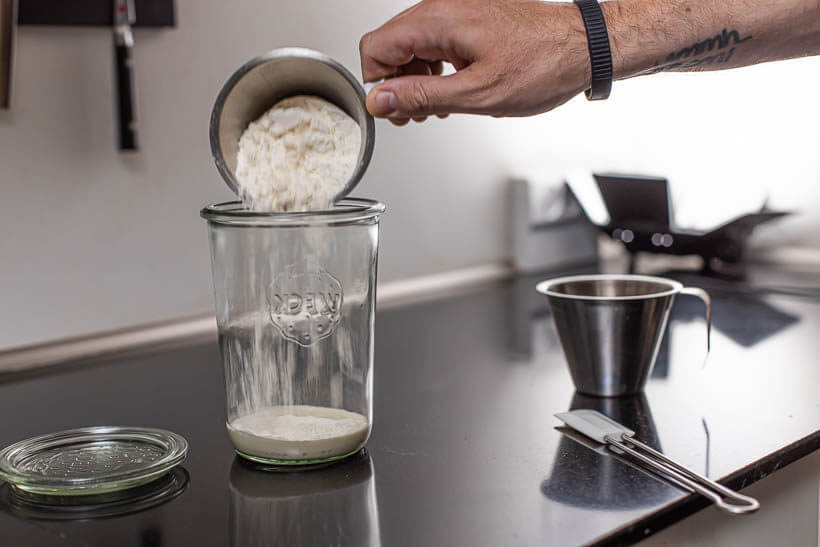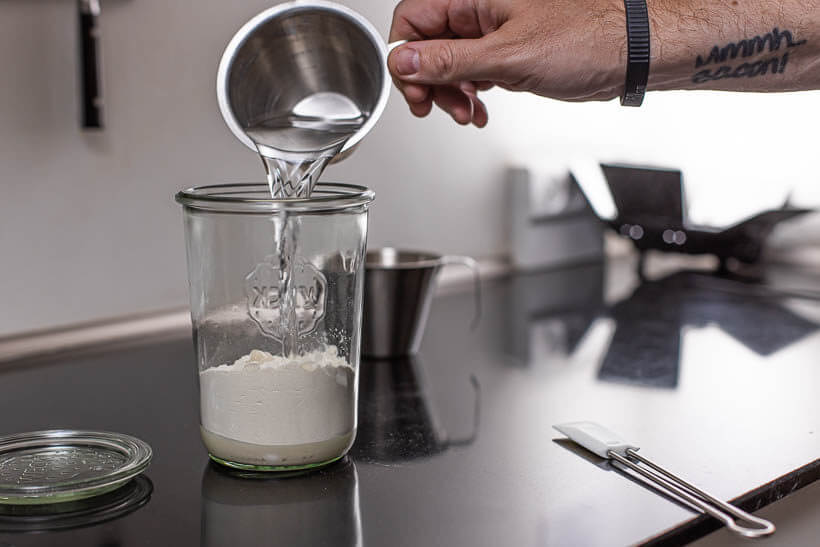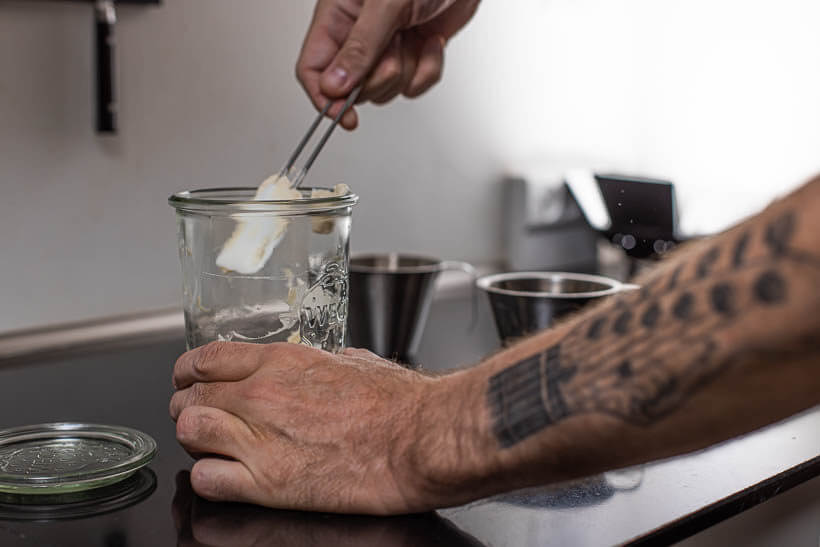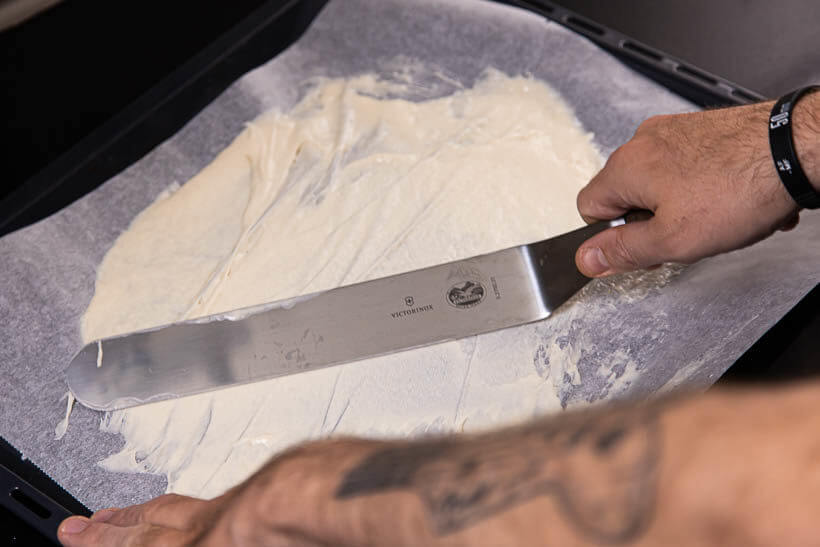After you’ve built an awesome, strong sourdough starter, you need to keep it alive. You must ensure it can grow to double or even triple its size. That way, it will be in great shape to help you bake awesome, delicious sourdough bread. Learn all my secrets to easy sourdough starter maintenance.
If you haven’t built a starter yet, you can go read my guide on how to do just that. It’s not really difficult, all you need is flour, water and patience.
The links to products in this article are ad links, which means I will get a commission if you click through and buy the product. I’ll only link to products that I already own or that are highly rated. The money earned from this commission will be used to run this blog and my YouTube channel.
When you’ve built a wonderful and active starter, you may even have given it a name. You want to keep it healthy and in the best condition.
The information in this article is also contained in this video if you prefer that format:
How do I fit all-day baking into my busy life?
Your sourdough starter maintenance will depend on your lifestyle and baking schedule. It can be difficult to fit sourdough bread baking into a busy life.
There’s something meditative about baking sourdough bread. I love the quiet work of nursing the dough, stretching and folding it, and shaping it, but I have a full-time job, so I can’t usually bake on a weekday.

I often bake my no-knead bread. As soon as I come home from work, I feed my starter and put it in the proofer set to 28°C/82°F. It’s usually tripled by 21:00/9 p.m. I then mix the dough, which I leave on the counter to ferment overnight.
I usually get up around 5:00/5 a.m. I will quickly check the dough, pre-shape it before breakfast, and then shape it after breakfast. I then put it in the fridge until I can bake it—usually, the same evening.
What kind of feeding schedule for great sourdough starter maintenance?
Well, that depends on how often you bake.
- If you bake every day, do this:
If you bake every day, it’s super easy. You just keep your starter out of the fridge, somewhere warm, and just feed it every day. - If you bake once a week or less, do this:
I see most other sourdough bakers recommending refrigerating their starter when they are not using it.
Then, the day before you need it, you take it out of the fridge and feed it a couple of times so the dormant yeast can wake up again.
What I do is a bit different, but it is a great option because your starter will always be ready for action.
So what you do is keep your starter out of the fridge at all times. If your kitchen is on the cold side, you may want to keep it in a proofer set to 28°C/82°F.

Then you feed it when you need it. I feed it about 4 hours before using it in dough or a levain. I will make 25g to 50g more than I need, which I will keep until the next time I need it.
I find it much easier to keep a super-active starter this way. When you put it in the fridge, the yeast goes dormant, and it will need a few feedings to get back in shape.
Keeping your starter out of the fridge will help it stay super active
I’ve even tried to see it coming out of the fridge downright sluggish and suddenly taking double the amount of time to grow, which can really be a pain when you work out a schedule for your different recipes that relies on your starter working a certain way.

I’ll leave it up to you to decide what works best for your schedule and your temperament. If you decide to follow my “keep it on the counter” routine, I suggest backing up your starter.
In general, it’s a good idea to keep a backup in case you are unfortunate enough to kill off your starter by some fluke.
Backing up your starter is a great sourdough starter maintenance practice
One way to keep such a backup is to put your active starter in a sealed container in your fridge. It will stay good indefinitely. Another and more permanent way to back up your sourdough starter is to dry it.
Feed your starter and let it grow to its peak. While it’s at its peak, smear some of the sourdough starter on a piece of parchment paper, really thin.

I find an offset spatula very helpful. Alternatively, you can use a regular silicone spatula.
Leave it to air dry for about 24 hours (or until completely dry and brittle). Break it up and store it in a plastic bag at room temperature.
How to get back to a regular starter from a dried starter
If worst comes to worst and your active starter and your fridge backup starter fail and you need to restore your dried starter, do the following:
- Weigh your dried starter.
- Add the same amount of water (by weight) to the dried starter.
- Mix until the dried flakes have dissolved. The smaller pieces you make, the faster this process will go.
- Then, add the double amount (by weight) of flour and the double amount of water and mix it really well.
- Then leave it somewhere warm for 6 hours.
- Hopefully, your starter grew a bit.
- Then, you can start with a 1:2:2 feeding proportion every time the starter is at its peak until it is sufficiently active. I prefer my starter to grow to triple its size for maximum rising power.
It’s that simple!
Please share this article on sourdough starter maintenance on social media
This is my article on how you maintain your sourdough starter. I hope you found it helpful and that you learned something.
Please consider sharing this article on social media so that fellow sourdough bakers can learn about sourdough starter maintenance.









